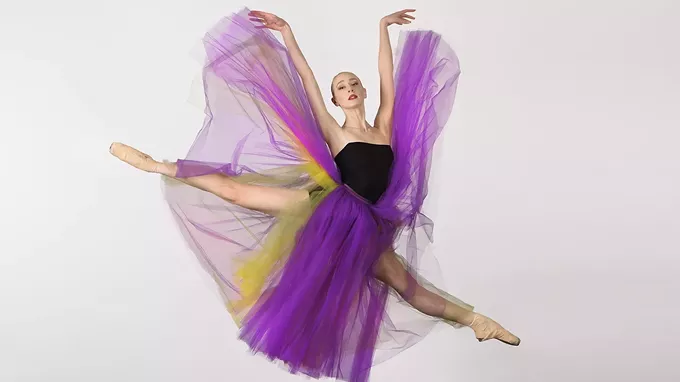Ballet Tucson
Winter Concert, Friday, Feb. 17, to Sunday, Feb. 19
Leo Rich Theater
The four dances in Ballet Tucson winter concert are exciting and varied. Once again, Ballet Tucson is performing a cherished George Balanchine dance. His “Allegro Brillante” is a challenging, romantic piece danced to Tchaikovsky’s Piano Concerto No. 3. The 13-minute performance demands strength and precision from the principal couple and eight other dancers. As Balanchine said himself, the piece “contains everything I know about the classical ballet.”
Resident choreographer Chieko Imada has created a new work, “Himiko,” inspired by the legendary Japanese Queen from the third century A.D. Thanks to the Tucson Desert Song Festival, she will have live music to pair with her dancers. Jing Xia will play the guzheng, a Chinese zither, and Bin Hu, classical guitar. Together they go by the name Duo Chinoiserie, and they will perform onstage with Ballet Tucson’s professional dancers. The score includes music by award-winning composer Yusuke Nakanishi.
In celebration of Valentine’s Day, the company mounts one of the sweetest duets in ballet, the “Romeo and Juliet Pas de Deux,” With music by Sergei Prokofiev. The two love birds dance in the beloved balcony scene. Artistic director Margaret Mullin has created a fresh new Pas de Deux to add to the company’s repertoire.
Price Suddarth, an award-winning choreographer based in Seattle, has contributed “Borderland,” featuring four dancers. The piece is about sleep and waking, tranquility and manic tension, dark and light, with music by Johann Sebastian Bach.
Spring Concert, Friday, March 24, to Sunday, March 26
Leo Rich Theater
Ballet Tucson’s Spring Concert offers five dances, including another Balanchine piece: “Walpurgisnacht Ballet.” He originated it as a small piece for the final act of a 1925 Paris Opera production of “Faust.” In New York, in 1975, he reimagined it as a stand-alone ballet. The dance is known for its many roles for women, 24 total, as Balanchine famously said, “ballet is woman.”
Mark Schneider, a regular guest choreographer, mixes jazz and ballet. His piece “Joplin,” is a crowd-pleaser set to the ragtime music of Scott Joplin. Imada’s piece “Bossa Nova” is a comedy for five dancers. Set in a 1950s Bossa Nova lounge, new connections lead to confusion and romance.
Suddarth’s choreography returns with the Ballet Tucson premiere of “First Light.” This fast-paced and athletic ensemble piece is set to the piano music of Carly Comando.
Each year “Footprints at the Fox” invites company dancers to choreograph their own pieces. Last October, the audience got to vote for their favorite, and, in the March show, dancer Brooke Amundrud will get to bring her winning piece to the Ballet Tucson mainstage.
University of Arizona School of Dance
dance.arizona.edu/news-events/events
In April, the professors and the young dancers will be hitting the stage at the Stevie Eller Dance Theater on the UA campus. In “Dance Springs Eternal,” the teachers and guest artists show off their own choreography, handing off the performance to their students. But the students have the stage to themselves for “Awakening: Student Spotlight,” presenting and performing works they have choreographed themselves.
The two shows alternate on different days on consecutive weekends in April, from Wednesday, April 19, to Sunday, April 30. To conclude the spring season, on Friday, May 5, and Saturday, May 6, Arianna Aquino, Cat Cogliandro, Gabriel Speiller, and Halston Strange will present their MFA graduate thesis projects, Loud Undertone, in the Stevie Eller Dance Theatre.













